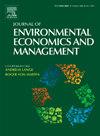Intra-firm pollution leakage and redistribution of pollution exposure: Evidence from coal-regulated plants in China
IF 5.9
3区 经济学
Q1 BUSINESS
Journal of Environmental Economics and Management
Pub Date : 2025-06-30
DOI:10.1016/j.jeem.2025.103205
引用次数: 0
Abstract
This paper examines the intra-firm pollution leakage and its distributional consequences on ambient PM2.5 induced by the Top 1000 energy conservation program on industrial plants in China. Using a combined data on plant-level pollution emissions, ambient PM2.5 concentration, and business ownership networks from 2001 to 2010, we identify the causal effects of the program on air pollution emissions by the plants and PM2.5 concentration in local neighborhoods affected by the emissions using a difference-in-differences strategy. The paper has two main findings. First, regulation-induced production transfer results in a leakage of 27 % in sulfur dioxide and coarse dust emissions from program-regulated plants to their affiliate plants. Second, the leakage shifts up PM2.5 near affiliate plants and results in a re-distribution of PM2.5 exposure towards socially disadvantaged rural neighborhoods where the affiliates are located in. These neighborhoods exhibit greater vulnerability due to less developed medical services and low health insurance coverage. Back-of-the-envelope calculations indicate that the leakage in pollution leads to a disproportionately higher leakage in health costs.
企业内部污染泄漏与污染暴露的再分配:来自中国燃煤电厂的证据
本文研究了中国工业企业节能1000强项目导致的企业内部污染泄漏及其对环境PM2.5的分布影响。利用2001年至2010年工厂级污染排放、环境PM2.5浓度和企业所有权网络的综合数据,我们使用差中差策略确定了该计划对工厂空气污染排放和受排放影响的当地社区PM2.5浓度的因果关系。这篇论文有两个主要发现。首先,法规诱导的生产转移导致27% %的二氧化硫和粗粉尘排放从计划监管的工厂泄漏到其附属工厂。其次,泄漏会使附属工厂附近的PM2.5上升,并导致PM2.5暴露重新分布到附属工厂所在的社会弱势农村社区。由于医疗服务欠发达和医疗保险覆盖率低,这些社区表现出更大的脆弱性。粗略的计算表明,污染的泄漏导致了不成比例的更高的医疗成本泄漏。
本文章由计算机程序翻译,如有差异,请以英文原文为准。
求助全文
约1分钟内获得全文
求助全文
来源期刊
CiteScore
8.00
自引率
4.30%
发文量
91
期刊介绍:
The Journal of Environmental Economics and Management publishes theoretical and empirical papers devoted to specific natural resources and environmental issues. For consideration, papers should (1) contain a substantial element embodying the linkage between economic systems and environmental and natural resources systems or (2) be of substantial importance in understanding the management and/or social control of the economy in its relations with the natural environment. Although the general orientation of the journal is toward economics, interdisciplinary papers by researchers in other fields of interest to resource and environmental economists will be welcomed.

 求助内容:
求助内容: 应助结果提醒方式:
应助结果提醒方式:


